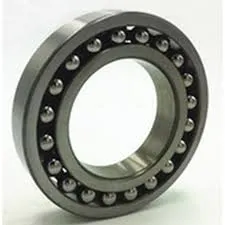
Nov . 10, 2024 00:48 Back to list
Understanding Thrust and Radial Bearings for Enhanced Mechanical Performance and Stability
Thrust and Radial Bearings Essential Components in Mechanical Systems
In the realm of mechanical engineering, bearings play a critical role in the performance and longevity of machinery. Among the various types of bearings, thrust and radial bearings are particularly important for supporting rotating elements and managing loads within machines. Understanding the differences and applications of these two bearing types can significantly enhance the design and efficiency of mechanical systems.
Thrust Bearings
Thrust bearings are designed to support axial loads, which are forces acting parallel to the axis of rotation. These bearings are essential in applications where there is a significant upward or downward force that must be countered. For instance, in a typical electric motor, the thrust bearings ensure that the rotor remains in place as it spins, absorbing any axial loads generated during operation.
One of the key features of thrust bearings is their ability to handle heavy loads with minimal friction. They are commonly constructed from materials like steel, ceramic, or polymer, depending on the specific requirements of the application. There are two main types of thrust bearings fluid film and rolling element bearings. Fluid film thrust bearings use a thin layer of lubricant to create a cushion between the surfaces, while rolling element thrust bearings utilize balls or rollers to minimize contact and reduce wear.
Radial Bearings
In contrast to thrust bearings, radial bearings are designed to support radial loads, which are forces acting perpendicular to the axis of rotation. Radial bearings are crucial for applications where components need to rotate smoothly while bearing the weight and lateral forces. A classic example can be found in automotive wheel bearings, where the radial loads from the vehicle's weight and road conditions must be efficiently managed.
thrust and radial bearing

Radial bearings come in various designs, including deep groove ball bearings, cylindrical roller bearings, and tapered roller bearings. Each design offers unique advantages in terms of load capacity, speed, and durability. Deep groove ball bearings, for example, are one of the most widely used types due to their versatility and ability to handle moderate axial and radial loads simultaneously.
Applications and Importance
Both thrust and radial bearings have broad applications across multiple industries. In the automotive sector, they facilitate smooth operation of engines, gearboxes, and wheels. In the aerospace industry, they ensure the reliability of aircraft components, including turbines and landing gear. Furthermore, home appliances, industrial machinery, and even medical devices rely on these bearings to function effectively.
The correct selection and implementation of thrust and radial bearings can significantly impact a machine’s operational efficiency, reliability, and maintenance needs. Engineers must consider factors such as load type, speed, operating conditions, and material choice when designing systems that incorporate bearings. Proper lubrication and regular maintenance are also essential to prolonging the lifespan of these components, minimizing wear, and reducing the risk of failure.
Conclusion
Thrust and radial bearings are fundamental elements in the mechanical engineering landscape. By understanding the distinct functions and applications of each bearing type, engineers can create more efficient and reliable systems. As technology continues to advance, the development of new materials and designs will further enhance the performance and durability of thrust and radial bearings, ensuring their role as critical components in modern machinery remains secure.
Latest news
-
Grooved Ball Bearing Design and Functionality
NewsJun.04,2025
-
Concrete Mixer Bearing Load Capacity Testing
NewsJun.04,2025
-
6004 Bearing Dimensions in Robotic Joint Designs
NewsJun.04,2025
-
Advantages of Single-Row Deep Groove Ball Bearings
NewsJun.04,2025
-
Applications of Deep Groove Ball Bearings in Automotive Systems
NewsJun.04,2025
-
Innovations in Bearing Pressing Machine Design
NewsJun.04,2025
